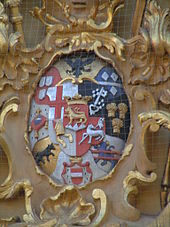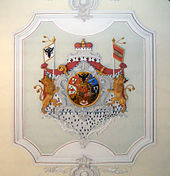Franz Georg von Schönborn
Franz Georg Reichsfreiherr ( Reichsgraf since 1701 ) von Schönborn (born June 15, 1682 in Mainz ; † January 18, 1756 in Philippsburg Palace , Ehrenbreitstein ), member of the von Schönborn family , was elector of Trier and prince abbot of Prüm from 1729 and from 1732 also Prince Bishop of Worms and Prince Provost of Ellwangen .
family



Franz Georg came from the Schönborn family. He was the ninth child of the Electorate of Mainz State Minister Melchior Friedrich von Schönborn (1644–1717) and the nephew of Elector Lothar Franz von Schönborn (1655–1729). His older brothers were the (prince) bishops Johann Philipp Franz von Schönborn , Friedrich Carl von Schönborn and Hugo Damian von Schönborn as well as the politician Rudolf Franz Erwein von Schönborn . He also had three younger brothers and seven sisters.
Franz Georg died in his Philippsburg Palace in 1756 after a long illness. His heart and entrails were buried in the Heilig-Kreuz-Kirche in Ehrenbreitstein, his body in Trier Cathedral.
Of his brothers, only Marquard Wilhelm (1683–1770), provost of Eichstätt and Bamberg, survived .
Life
education
Franz Georg spent his youth in Aschaffenburg , where he attended the Jesuit college together with his younger brother Marquard Wilhelm and was accepted into the clergy on December 19, 1695 by receiving the tonsure . Together with his brother, he became domicellar at the cathedral monastery of St. Peter in Trier in 1700 , and canon at the beginning of the following year . On May 4, 1701 Franz Georg was born by Pope Clement XI. appointed provost of St. Moritz in Augsburg , where he stayed from September. From 1702 he studied canon law, philosophy and theology in Salzburg , again together with Marquard Wilhelm . When the War of the Spanish Succession broke out , the brothers left unsafe Salzburg and went to Italy. At the behest of their father, they continued their studies in Siena , where mainly civil law, geography and history were taught. After the brothers were briefly at home in the summer of 1704, their father sent them to the University of Leiden to continue their legal studies until 1706. The brothers had traveled extensively during their student days and were received by the Pope and at various royal courts. After finishing their studies in Leiden, they parted ways. Marquard Wilhelm found his sphere of activity near Bamberg.
politics
His uncle, Arch Chancellor Lothar Franz von Schönborn , appointed Franz Georg to the Electoral Mainz envoy to the Holy See . Then Franz Georg received the order, Karl VI. in Barcelona to bring the news of his election as emperor, for which he was awarded the Knightly Order of St. James of Compostela was awarded. At the imperial coronation in Frankfurt am Main in 1711 , carried out by his uncle as Arch Chancellor, Franz Georg represented the absent Imperial Chamberlain and thereby advanced to the position of Imperial Chamberlain . In the following year 1712 he became Reichshofrat , in 1713 he was ambassador of the Franconian Circle at the Peace Congress in Utrecht , in 1717 he became Imperial Privy Councilor . In 1715, through papal commission , he came into the possession of a Munster prebende , who had become free through the death of Canon Franz Anton von Lorraine .
When his Mainz uncle died in 1729 and the previous Archbishop of Trier succeeded him in Mainz, Franz Georg was the most promising candidate to succeed him in Trier. He was elected unanimously and ordained a priest and bishop by his brother Friedrich Carl. Thanks to papal protection, he also became Prince-Bishop of Worms and Prince-Provost of Ellwangen three years later .
Although he was pious himself, Franz Georg was open to the Enlightenment and strove to improve popular education. He also forbade certain folk customs, pilgrimages , holidays and exorcism .
Franz Georg was politically close to Habsburg and therefore saw his Kurlande constantly involved in the conflicts of the great powers during the first half of his reign. Towards the end of his life he saw the decline in his family's influence in the empire.
Construction activity
St. Paulin in Trier (from 1734)
In the second half of his term of office, Franz Georg withdrew from politics and concentrated on administration and building projects. a. the entire complex of the baroque residence in Ellwangen (1737–1753). In 1734 he laid the foundation stone for the new construction of the St. Paulin Church in Trier, which he financed from his own resources. The single-nave baroque church is attributed to Christian Kretzschmar , the rich interior was designed by Balthasar Neumann , the house and court architect of the Schönborn family and especially his brother Friedrich Carl . From 1739 Franz Georg expanded his residence near Koblenz , the Philippsburg Palace in Ehrenbreitstein , to include the dicastery building , also based on Neumann's design and with the assistance of Johannes Seiz . From 1740 Franz Georg had Neumann plan a new church for his summer residence in Dirmstein , Palatinate , the baroque two-church St. Laurentius . Rescheduled by the local master builder Franz Rothermel to save costs , it was built within four years and consecrated in 1746. In 1748 Franz Georg had Andreas Seitz rebuild the abbey building in Prüm , also based on plans by Balthasar Neumann . He also commissioned the construction of the parish church of St. Michael in Lampertheim-Hofheim (1747–1754), again based on plans by Neumann. Franz Georg had the Schönbornslust hunting lodge built in Kesselheim by 1752 , which was destroyed in 1794 after it was conquered by French revolutionary troops.
Dicastery building of Philippsburg Palace in Koblenz
Prüm Abbey with St. Salvator's Basilica
Laurentius Church in Dirmstein
literature
- Constantin von Wurzbach : Schönborn, Franz Georg Graf . In: Biographisches Lexikon des Kaiserthums Oesterreich . 31st part. Imperial and Royal Court and State Printing Office, Vienna 1876, p. 135 ( digitized version ).
- Leopold von Eltester : Franz Georg . In: Allgemeine Deutsche Biographie (ADB). Volume 7, Duncker & Humblot, Leipzig 1877, pp. 308-310.
- Heribert Raab : Franz Georg Graf von Schönborn. In: New German Biography (NDB). Volume 5, Duncker & Humblot, Berlin 1961, ISBN 3-428-00186-9 , p. 370 f. ( Digitized version ).
- Franz Zierlein: Count Franz Georg von Schönborn 1682–1756 . In: Ellwanger yearbook . tape 1969/1970 .
- Christof Dahm : Franz Georg von Schönborn. In: Biographisch-Bibliographisches Kirchenlexikon (BBKL). Volume 9, Bautz, Herzberg 1995, ISBN 3-88309-058-1 , Sp. 623-627.
Web links
- Literature by and about Franz Georg von Schönborn in the catalog of the German National Library
- Entry on Franz Georg von Schönborn on catholic-hierarchy.org ; accessed on October 20, 2019.
- Franz Georg von Schönborn in the Saarland biographies
- History of the lost Schönbornlust Palace near Koblenz-Kesselheim
- Article depicting the resurrection altar (tomb in Trier Cathedral)
- Summer residence of the Dirmstein Castle of Prince-Bishop Franz Georg von Schönborn of Worms
- Buildings of the Prince Provost Franz Georg Graf von Schönborn in Ellwangen (Jagst)
- Photo of the Dikasterialbau Ehrenbreitstein / Koblenz of Trier Archbishop Franz Georg Graf von Schönborn
Individual evidence
- ↑ Balthasar Neumann: Order from the neyen church in Dirmstein . Two sheets with floor plan or west view . (Originals in the archives of the Diocese of Speyer).
- ↑ A sensational art historical discovery . In: Grünstadter Latest News . Grünstadt July 22, 1914 (original in the archives of the Diocese of Speyer).
- ^ Franz Rothermel: sketch of the floor plan . (Original in the central archive of the Evangelical Church of the Palatinate (Speyer), Dept. 170, No. 698).
| predecessor | Office | successor |
|---|---|---|
| Franz Ludwig of Pfalz-Neuburg |
Elector Archbishop of Trier 1729–1756 |
Johann Philipp von Walderdorff |
| Franz Ludwig of Pfalz-Neuburg |
Prince-Bishop of Worms 1732–1756 |
Johann Friedrich Karl von Ostein |
| Franz Ludwig of Pfalz-Neuburg |
Prince Provost of Ellwangen 1732–1756 |
Anton Ignaz von Fugger-Glött |
| personal data | |
|---|---|
| SURNAME | Schönborn, Franz Georg von |
| ALTERNATIVE NAMES | Schönborn, Franz Georg Baron von (full name); Schönborn, Franz Georg Reichsgraf von (full name) |
| BRIEF DESCRIPTION | Elector of Trier, prince abbot of Prüm, prince-bishop of Worms, prince provost of Ellwangen |
| DATE OF BIRTH | June 15, 1682 |
| PLACE OF BIRTH | Mainz , Germany |
| DATE OF DEATH | January 18, 1756 |
| Place of death | Philippsburg Castle , Koblenz , Germany |







